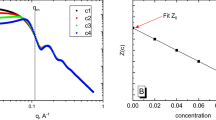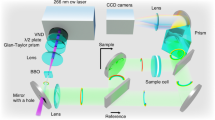Abstract
THE possibility of using the Raman effect for quantitative analysis depends upon two conditions: (1) The components of the mixture in question should possess distinguishable spectra, a requirement depending on the nature of the molecules. (2) The photographed spectra should be sufficiently intense and the background clear enough to provide good microphotometer measurements. The accompanying account concerns an investigation of these conditions in the case of amino acid solutions.
This is a preview of subscription content, access via your institution
Access options
Subscribe to this journal
Receive 51 print issues and online access
$199.00 per year
only $3.90 per issue
Buy this article
- Purchase on Springer Link
- Instant access to full article PDF
Prices may be subject to local taxes which are calculated during checkout
Similar content being viewed by others
References
R. W. Wood, ” Physical Optics” (3rd Edition 1934).
NATURE, 136, 300 (1935). See also J. T. Edsall, J. Chem. Physics, 4, 1 (1936).
Author information
Authors and Affiliations
Rights and permissions
About this article
Cite this article
WRIGHT, N., LEE, W. Raman Effect as a Method of Analysis of Amino Acid Solutions. Nature 139, 551–552 (1937). https://doi.org/10.1038/139551a0
Issue Date:
DOI: https://doi.org/10.1038/139551a0
Comments
By submitting a comment you agree to abide by our Terms and Community Guidelines. If you find something abusive or that does not comply with our terms or guidelines please flag it as inappropriate.



